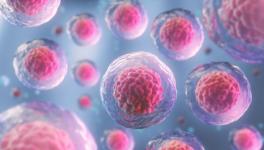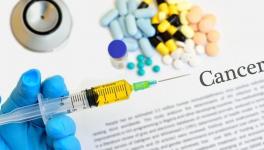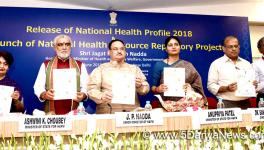Molecular Pharma in Breast Milk: The Path Ahead

Representational Image. Image Courtesy: Freepik
Mothers' milk, for infants, possesses specific nutritional and immunological advantages where proteins, carbohydrates, lipids, and other bioactive factors play a crucial role in neonates' growth, immune protection, and general health. Recent scientific research has revealed that apart from feeding advantages, molecular factors, have been identified that help neonates and can even be transposed to medical practice and the treatment of diseases.
Molecular Complexity
Over the evolutionary time of mammals, mother's milk has attained the complex array of molecules now discovered in human breast milk. Among the features to note are the human milk oligosaccharides (HMOs), essentially a short chain of sugar molecules. HMOs uniquely play the role in immune defence as they prevent babies from becoming victims of infections and being subjected to detrimental processes of inflammation. Beyond the HMOs, there are proteins, vitamins, hormones, and live cells in breast milk-- so needed for any baby's development.
The molecules identified as of 2009 were more than 250 proteins and by about 2015 around 300 microRNAs (miRNAs) -- that are short chains of ribonucleic acids or RNA, implicated in the regulation of gene expression. The various classes of miRNAs play important roles in cellular growth, function of the immune system, and metabolism. These miRNAs in breast milk, for instance, miR-148a-3p and miR-125b-5p, have been associated with the regulation of infant development and modulating processes, such as the regulation of gastrointestinal system development, epigenetic changes that control DNA function and also regulation of immune responses.
Recently, it has been seen that there are cells--even stem cells--in breast milk; thousands to millions of maternal cells per millilitre. Technology breakthroughs have shown cells in the mother's milk to be multilineage and thus able to differentiate to all other types of cells. Here lies the benefit from the stem cells that nursed babies and mothers alike acquire, while the benefits for regenerative medicine are enormous. The self-renewing, differentiating stem cells dwelling in the mother's milk is a landmark in the study of biological functions of mother's milk.
Unlocking Medicinal Potential
Recent studies have identified approximately 50,000 small molecules present in breast milk; many of these have not yet been explored. Very recently, thanks to the use of artificial intelligence (AI), researchers began to discover an association between these molecules and health outcomes in both infants and adults.
Another very promising area of research is on the anti-inflammatory properties of HMOs and how these might be adapted into therapies for chronic conditions, such as heart disease or arthritis. For instance, work by Lars Bode at the University of California showed that HMOs could prevent blockage in the arteries, a major cause of heart attack.
The discovery of human breast milk stem cells (hBSCs), holding multilineage potency, creates a new door for regenerative medicine. Their characteristics would most probably resemble those of human embryonic stem cells since it differentiates to all types of cells derived from the three germ layers or species of tissue, such as neural, mesodermal, and endodermal cells.
Their multilineage potential makes them good candidates for therapies against neurodegenerative diseases such as Parkinson's or Alzheimer's. The non-tumorigenic property of hBSCs adds safety to the use of stem cell therapies, particularly important in the context of commonly used induced Pluripotent Stem Cells (iPSCs), in which the possibility of tumorigenesis always exists.
Researchers at Lund University, Sweden, discovered that a molecular complex formed by alpha-lactalbumin and oleic acid, two components of breast milk, was a potent cytotoxin against lung carcinoma cancer cells. The molecule was christened HAMLET. They have proved to be clinically effective where results of complete shrinkage of the tumour were observed in 88% of patients suffering from carcinoma of the bladder.
The state of affairs proved very encouraging and opened further avenues for research into cancer therapy using breast milk. In addition, many miRNAs from breast milk, like miR-375-3p, have been proved to show anti-cancerous properties mostly in the carcinoma of the breast. The microRNA plays a role in controlling apoptosis in tumour cells or cell death, presenting yet another route toward being examined for cancer therapy within the constituents in breast milk.
Prolacta Bioscience is researching how the constituents of human breast milk aid in the recovery of adults who receive bone marrow transplants to treat blood cancer. Early pilot studies report that infection was reduced in children who have similar treatments.
Breast milk is very important to the infant gut microbiome because the bacterium Bifidobacterium which is present in it is a specific group that feeds on HMO. This interaction, therefore, creates an ideal gut microbiome for infants to live healthy. Now, since it has already proven to cure some cases of irritable bowel syndrome, scientists are researching its effectiveness or benefits to adults.
There is great interest in the neuroprotective properties of breast milk especially for premature infants. Experiments conducted at the Children's Hospital in Cologne proved that nasal administration of breast milk into preterm babies with brain injuries minimises brain damage and reduces surgical interventions. Another study by researchers of the Hospital for Sick Children in Toronto proved intranasal breast milk to be effective in preventing haemorrhages in the brains of preterm infants, especially on motor and cognitive outcomes. Researchers believe that the neuroprotective effect is there in stem cells present in breast milk.
Furthermore, neurotrophic factors in breast milk, such as brain-derived neurotrophic factor (BDNF) and glial cell line-derived neurotrophic factor (GDNF) are concerned with the development of the enteric nervous system and survival of neurons. They seem of prime importance in health in infants, and quite conceivably in adults, though undoubtedly much less obviously, they play some role in managing neurodegenerative diseases.
Challenges and Future
While the industry is constantly trying to implicate some of the benefits found in breast milk into its infant formula, it remains impossible to make an exact replica. More advances in technology have kept companies abreast with putting together HMOs and other bioactive components in the formulas which later translate to better gut health for infants fed on the formulas.
Two start-ups -- Helaina and Biomilq -- are also doing their best to develop a bioengineered version of breast milk proteins and fats but these remain in nascent stages. In fact, other molecules, like breast milk-derived miRNAs, are basically absent in most formulas and play a pivotal role in the immune system and developmental programming. These formulas are still far from matching the complexity of human milk's biological functions.
Continuing research into breast milk reveals its increasing potential. It is increasingly being seen as a promising tool in the fight against major health challenges, such as cancer, heart disease, and neurodegenerative disorders. The challenge now is to harness its benefits ethically and equitably, so that the benefits of breast milk science continue to benefit society at large without compromising the natural integrity of human lactation.
There is rather significant potential in breast milk molecules that will change the nursing of infants and transform adult medicine. Scientific knowledge today is still increasing, and soon, breast milk might become an excellent resource for modern medicine.
Commercialising breast milk raises questions of ethical nature mainly about equal access and sourcing. Harvesting and selling a breast milk component for money demands strict regulating principles to ensure ethical matters. Scientists, policymakers, and the private companies themselves must work together to set clear ethical guidelines for the development and application of therapies made from breast milk. The context has to be the health and well-being of the public and not the profits that will benefit big pharma and businesses.
The writer is a retired Professor, School of Biotechnology, Madurai Kamaraj University. He is in the All-India People’s Science Network. The views are personal.
Get the latest reports & analysis with people's perspective on Protests, movements & deep analytical videos, discussions of the current affairs in your Telegram app. Subscribe to NewsClick's Telegram channel & get Real-Time updates on stories, as they get published on our website.
























